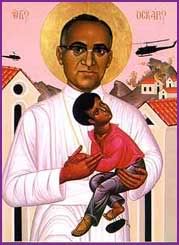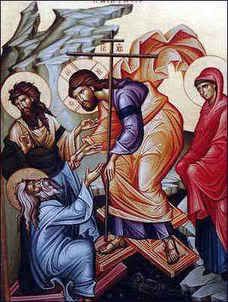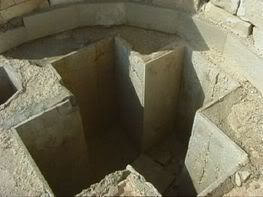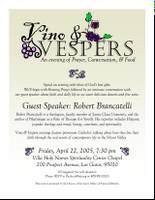By Rosa MelendezFirst year student of the Institute for Leadership in Ministry (ILM)Editor's note: The following was a paper written for one of Rosa's classes in the ILM. She generously shares with us her insights from her class as well as personal experience as a Salvadoran on the 25th anniversary of the assassination of Archbishop Oscar Romero, March 24, 2005.
Studying about Liberation Theology has had a tremendous impact on me personally, as I look back on my own Master Story in light of what happened in my country—El Salvador. Specifically, how the life of Monsignor Romero, his ministry and conversion was a propelling force in the Liberation Theology that emerged out of the affliction of the Salvadoran peoples.
In this paper I will talk about what liberation theology is, how it originated and how El Salvador is an example of liberation theology at work. Particularly, how Monsignor Romero’s life experience and conversion intertwine in the development of the liberation theology that emerged out of the struggle and suffering of the peoples of El Salvador. I will also explain the three-step critical analysis that is necessary to determine if liberation theology is present. And how in light of the Scriptures do we discern and are compelled to change the repressive structures that give birth to the situation. In Spanish we call this process:
ver, juzgar, y actuar (see, judge, act).
Elizabeth E. Johnson, a leading theologian of our era defines liberation theology as a “new way of doing theology, one which draws on the experience of systematically oppressed and suffering peoples.” In her book,
Consider Jesus, she explains that liberation theology originated in Latin America after the Second Vatican Council. She goes on to explain that this theology can be recognized where there is suffering of a particular group of people, and even though it is closely related to oppression, it shows up differently, i.e., poverty, political disenfranchisement, patriarchy, apartheid, etc. In other words, not all liberation theology is the same. It emerges when community is formed; people come together in faith, become aware of their situation, pray, study the Scriptures and in light of the Scriptures are compelled to seek action to change their situation for the better. “The reflexion of liberation theology is intrinsically intertwined with what is called praxis, or critical action done reflectively.” In other words, to do liberation theology, one must act on behalf of justice.
The first step in the critical analysis is that we must recognize if a situation is really oppressive, name it a sin—not only individual but a collective sin—and consider its root causes. In the case of El Salvador, Monsignor Romero started by asking: Is it God’s will that so many people are deprived of their livelihood? That they are malnourished? That children die, that there is no adequate education, no medical benefits, no shelter and thus, children are thrown into prostitution and abuse? The answers became clear, extreme poverty, political disenfranchisement, and the teaching of the church contributed to their suffering. Obviously this is wrong; the question is why. What came up to light was the fact that a few people owned the land—14 families produce the coffee, cotton and control the export of the products. They called the shots—from backing up presidents that sought only after their own needs, to the flow of money to industry and everything else; in summary, controlled the economy, the government, the police, and the armed forces thus there was no opportunity for anyone else to prosper, or speak up.
Out this oppressive situation, Liberation theology emerged. The majority of Salvadorans came together in faith, became conscious of their own situation, prayed, studied the Scriptures, and listened to the voice of the one who became their leader, Monsignor Romero, not a willing leader at first, but being forced to see the reality of his people, began to act, to shine light on the many injustices committed against the Salvadorean people. He began to use the pulpit to preach powerful homilies, to voice the concerns of the suffering peoples, and to denounce the crimes against those who dare threaten the status quo. His homilies were heard throughout El Salvador:
The day when all of us Salvadoreans escape from that heap of less-human conditions and as persons and a nation live in more-human conditions, not only of merely economic development, but of the kind that lifts us up to faith, to adoration for only one God, that day we will know our people’s real development.
Community as never seen before gathered in search for answers. A radical search for better structures followed, but not without taking its toll. Many, many died in that quest. Many of my friends with whom I went to the University were killed during demonstrations; many became widows and much poverty ensued. However, out of this interaction the true meaning of faith arose.
The second step in the critical analysis is to look whether Christian tradition has contributed to the situation. Questions such as what elements of our tradition have lent themselves or contributed to the problem? Where is the complicity of the church and its preaching? How has Christ been understood in a way that is helpful to the oppressor?
According to Johnson’s methodology, a critical analysis of the role the church played in this situation shows that the tradition of Christology has supported this situation of injustice, and I’m afraid it continues to date. For instance Johnson points out, mysticism of the dead Christ in Latin American piety, symbolized in graphic crucifixes and in Holy Week processions in which the dead Christ is carried and pious folks mourn as if he had just died. This is coupled with a spiritual identification with Christ as a model. Emphasis on the dead Christ works to legitimize suffering as the will of God. It is taught that Jesus Christ suffered quietly and passively; he went to the cross like a sheep to the slaughter and opened not his mouth. The outcome is clear: to be a good Christian one should suffer quietly; one should go to the cross and not open one’s mouth; one should bear one’s cross in this world and, after death, God will give us our eternal reward. “When embraced in a situation of injustice, this pattern of piety promotes acceptance of the status of victim, and anyone who dares challenge their suffering would be seen to go against the example of Christ. It obviously works to the advantage of the oppressor.”
Another difficulty identified in the tradition is the glorification of the imperial Christ—in heaven the risen Christ rules. It’s preached that he sets up on earth human authorities to rule in his name, both in the civil and ecclesiastical spheres. Human authorities represent Christ and are to be obeyed as one would obey him. What happens here is that in an unjust situation this puts Christ in the same group with the dominating powers, and anyone who challenges either authority is disobeying the will of God. This is painful to see and hear. I remember when Monsignor Romero himself followed this tradition and sited with the rich. He was seen as one of the “establishment” of the ruling class. I also remember hearing my own father making statements such as: You can pray all you want, but there will not be priests in this house! You cannot go to church, it’s too dangerous, besides the priests are told what to bless and so it is done! Don’t break any rules, don’t talk outside of this house, you never know who is listening. His statements were typical of the situation we were living—a police state—and they were commonly heard by all of us students and the general population. They were a product of the fear and oppression that invaded our lives. I for one was torn between the extremes. I could see my father’s conservative point of view and the threat to “our way of life,” on the other hand, I could hear the clamor of the people, and much more as a Law students.
The third step comes about, Johnson states, when we read the Scriptures from the perspective of the poor, it makes it very clear that Jesus is on the side of the downtrodden and calls oppressors to conversion. A key text is the scene in Luke where, at the beginning of his ministry, Jesus goes to his home synagogue in Nazareth and reads from the scroll of Isaiah.
The Spirit of the Lord is upon me, because he has anointed me to preach the good news to the poor; he has sent me to proclaim release to the captives and recovery of sight to the blind, to set at liberty those who are oppressed, to proclaim the acceptable year of the Lord.
Sitting down, Jesus says, “Today this scripture is being fulfilled in your hearing” (Lk 4:16-21). This prophecy sets the agenda for Jesus’ ministry, as we see from everything that follows in the gospels. His preaching that the reign of God is near; his singling out the poor and those who hunger after justice for beatitude; the way he feeds and heals and welcomes outcasts—all of this reveals a choice, a preference for those who have not. This is God’s agenda for the poor: that they be released and set at liberty from grinding poverty and oppression. This is good news for the victims. It means that their present situation is not the last word about their lives, but that God has another design in mind. Touching structures as well as hearts, God is opening up a new future for the poor.
The message is clear; Jesus die for us so that we could be free. We ought not to be fixed on the cross but set our eyes on the resurrection. He came to transform us from poor oppressed people into free individuals capable of thinking, working and having the right to earn a decent living. Jesus was not a passive victim. His death came about as a result of a very active ministry in which love and compassion for the dispossessed led him into conflict with the powerful.
And so is the example of Monsignor Romero’s life to the Salvadoran people. At first, he adhered to the traditional teachings of the church and did not want to create any waves; however, he was forced to look at the situation when Fr. Rutilio Grande who was not in agreement with him, was assassinated because he was helping the poor, the heads of the unions who were working to bring about change for a more humane treatment and payment of the factory workers. These workers who daring to question the oppressors, were persecuted and killed by the “mano blanca” or death squads. Monsignor Romero was forced to see that to continue to do nothing was in fact endorsing the behavior of the ruling class. His voice became more powerful, more determined.
When we struggle for human rights, for freedom, for dignity. When we feel that it is a ministry of the church to concern itself for those who are hungry, for those who are deprived, we are not departing from God’s promise. He comes to free us from sin, and the church knows that sin’s consequences are all such injustices and abuses. The church knows it is saving the world when it undertakes to speak also of such things.
Monsignor made the Scriptures come alive; his voice could not be denied, and to his demise, he became a real threat to the status quo. Shortly after, he was killed while saying mass.
Here are more examples of his homilies that show his transformation and conversion and became powerful revolutionary thought calling for change and conversion for all of us. What it points out is that one must not be silent when there is oppression and suffering of the people of Our Lord. Monsignor Romero was forced, as I am right here to see what was/is the problem of the people in my country, how the church/preaching contributed to their plight, and finally, looking at this experience, what in the tradition of Christology was overlooked and, in light of the experience of the poor, might be used to shape a Christology that can liberate. It is sad to see, however, that the situation continues and it might have gone back to the same causes. Further, the current Bishop is a Spaniard who does not seem to share the same interest for the good of the people of El Salvador. Again, the situation seems to be a time bomb. It is calling us again to go back, to remember that we are each others keeper and that we must speak for those who cannot speak for themselves.

 The Paschal Candle holds a pre-eminent place among all candles used in church, for it is a symbol of Christ and is "the light of Christ, rising in glory," scattering "the darkness of our hearts and minds" (Sacramentary, The Easter Vigil, 12). In the Easter Proclamation (Exsultet), the Paschal Candle is called a "pillar of fire" (reminding us of the Israelites flee from Egypt [Ex 14:21]) that mingles with the lights of heaven and "glows to the honor of God." Contrary to the multitude of Easter lilies that appear in churches during this time, "the Easter Candle is the Catholic Easter symbol" (The Lent Triduum, and Easter Answer Book, Paul J. Niemann).
The Paschal Candle holds a pre-eminent place among all candles used in church, for it is a symbol of Christ and is "the light of Christ, rising in glory," scattering "the darkness of our hearts and minds" (Sacramentary, The Easter Vigil, 12). In the Easter Proclamation (Exsultet), the Paschal Candle is called a "pillar of fire" (reminding us of the Israelites flee from Egypt [Ex 14:21]) that mingles with the lights of heaven and "glows to the honor of God." Contrary to the multitude of Easter lilies that appear in churches during this time, "the Easter Candle is the Catholic Easter symbol" (The Lent Triduum, and Easter Answer Book, Paul J. Niemann). “The Sequence, which is optional except on Easter Sunday and on Pentecost Day, is sung before the Alleluia” (
“The Sequence, which is optional except on Easter Sunday and on Pentecost Day, is sung before the Alleluia” ( During the Easter season it is appropriate to use holy water taken from the baptismal font for the Sprinkling Rite. When this is done, the usual prayers of blessing found in the Sacramentary ("The Order of the Mass," Rite of Sprinkling, A-C) are not used, since the water has already been blessed at the Easter Vigil.
During the Easter season it is appropriate to use holy water taken from the baptismal font for the Sprinkling Rite. When this is done, the usual prayers of blessing found in the Sacramentary ("The Order of the Mass," Rite of Sprinkling, A-C) are not used, since the water has already been blessed at the Easter Vigil.

 Singers: I know you're out there! I've seen you in action in choirs and as cantors throughout the diocese. We have lots of talent out there, and now I need you to come together to bring that talent to one of our best events in the diocese.
Singers: I know you're out there! I've seen you in action in choirs and as cantors throughout the diocese. We have lots of talent out there, and now I need you to come together to bring that talent to one of our best events in the diocese. To assist with the blessing of oils at the Chrism Mass on March 15, 2005, 7:30p at the Cathedral, each parish and institution that reserves Holy Oils is asked to send three representatives to present the oils for blessing during the Mass. They should be selected in advance for this responsibility and be at the Cathedral by 6:45p on March 15.
To assist with the blessing of oils at the Chrism Mass on March 15, 2005, 7:30p at the Cathedral, each parish and institution that reserves Holy Oils is asked to send three representatives to present the oils for blessing during the Mass. They should be selected in advance for this responsibility and be at the Cathedral by 6:45p on March 15.